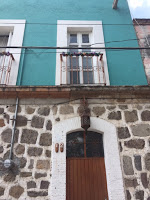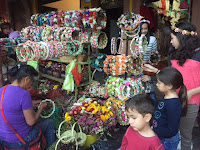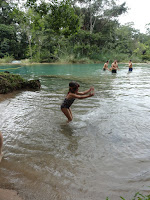 I sit here on Christmas Eve morning, enjoying my cup of hot coffee, reflecting on all the joys and blessings bestowed upon us this year, and listening to 3 of the kids playing Minecraft together in the next room. Alex and Juliana are enjoying the opportunity to sleep in, and I am enjoying the leisurely pace that this morning brings.
I sit here on Christmas Eve morning, enjoying my cup of hot coffee, reflecting on all the joys and blessings bestowed upon us this year, and listening to 3 of the kids playing Minecraft together in the next room. Alex and Juliana are enjoying the opportunity to sleep in, and I am enjoying the leisurely pace that this morning brings.

We arrived in San Miguel de Allende about a week ago and are quickly getting to know our new adopted neighborhood. We are staying in a lovely historic building, which used to house the workers of former textile mill across the street. That factory has since been turned into an artistic center, home to a wide variety of artist studios and galleries. It's a place you can easily spend days wandering and enjoying the art and the people. It's difficult to get out of there without spending a few (or a lot) of pesos on very beautiful items.
We have been taking it slow this week: our first night here, all four kids got incredibly sick and we spent all night in the restroom, mopping and re-mopping floors and changing sheets. Thankful for the washing machine and that we aren't washing sheets by hand (as I did during my college semester abroad). Little things make a big difference!

 After we nursed everyone back to health, we celebrated Miriam's 7th birthday! To be safe, we spread it across two days - actual birthday for presents and next day for cake (to be extra safe on the recovery of all stomachs). In the end, it was fun! And Miriam, the only of our kids who doesn't have a summer birthday, finally got a chance to wear short sleeves outside on her special day!
After we nursed everyone back to health, we celebrated Miriam's 7th birthday! To be safe, we spread it across two days - actual birthday for presents and next day for cake (to be extra safe on the recovery of all stomachs). In the end, it was fun! And Miriam, the only of our kids who doesn't have a summer birthday, finally got a chance to wear short sleeves outside on her special day! After birthday celebrations passed, we moved on into our Christmas mode! One of the things we really wanted the kids to experience in Mexico, was how the Christmas season is celebrated. There are things Alex experienced growing up here, that simply don't lend themselves to the Michigan climate in December: specifically the Posadas.
Posadas occur nightly from December 16 through Christmas Eve and are essentially a parade of people revisiting of the pilgrimage of Mary and Joseph into Bethlehem and their search for a place to stay. Some Posadas are private events, held by a specific church parrish or neighborhood. And there are also centrally sponsored public Posadas, which are held in different parts of the city center. Here, the place (usually a church) where any given Posada ends one night, is the place where it will begin the next night.
 We participated in a Posada that began in the block behind our house and ended at one of the churches downtown. Leading the parade was the image of the Virgen de Guadalupe (patron saint of Mexico), young people dressed as María (riding a donkey) and José (Mary and Joseph), a group of children dressed as pilgrims and shepherds, and a group of musicians who led the rest of the public in song. Lyrics were handed out so we could all participate. Then our procession wound through the city streets, with traffic cops managing the cars along the way. In different places, the crowds along the route threw candy or goody bags to the participants in the Posada, called aguinaldo. The Posada ended at the door of the church, where María and José and ask for posada (a place to stay). After it is eventually granted, the crowd celebrates with a "ponche", a hot Christmas punch and song. In many cases, the end also includes the breaking of a piñata, filled with sweets, fruit, and baby jicamas. More bags of aguinaldo are handed out to all participants. Of course the kids found this to be fantastic fun, as they were loaded up with bags of goodies, and we proceeded to the main city square, which was crowded with families enjoying the music, food, and fun.
We participated in a Posada that began in the block behind our house and ended at one of the churches downtown. Leading the parade was the image of the Virgen de Guadalupe (patron saint of Mexico), young people dressed as María (riding a donkey) and José (Mary and Joseph), a group of children dressed as pilgrims and shepherds, and a group of musicians who led the rest of the public in song. Lyrics were handed out so we could all participate. Then our procession wound through the city streets, with traffic cops managing the cars along the way. In different places, the crowds along the route threw candy or goody bags to the participants in the Posada, called aguinaldo. The Posada ended at the door of the church, where María and José and ask for posada (a place to stay). After it is eventually granted, the crowd celebrates with a "ponche", a hot Christmas punch and song. In many cases, the end also includes the breaking of a piñata, filled with sweets, fruit, and baby jicamas. More bags of aguinaldo are handed out to all participants. Of course the kids found this to be fantastic fun, as they were loaded up with bags of goodies, and we proceeded to the main city square, which was crowded with families enjoying the music, food, and fun.
Another tradition we have had the opportunity to enjoy are the Pastorelas. This is a Christmas pageant which includes a high degree of Mexican humor and often some sort of twist. You can attend many and they will all be different. Even with limited Spanish, the kids were doubled over laughing the whole time! We found one by accident, as we were wandering the streets and found an angle peeking out of a door in the wall around a church. We asked if they were going to do a Pastorela, and were immediately invited in. The kids concluded that if we find another, we are definitely going!
So today we will continue our explorations to see what we find... We will go to a mass at one of the many beautiful churches in our downtown. And we will see what other exciting events we discover downtown. Merry Christmas to all! May we all bring peace and joy to those around us in this year ahead!














































